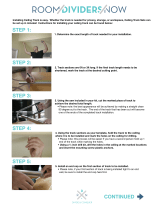
PREINSTALLATION CONSIDERATIONS
This operator includes parts and supplies needed for installation in MOST garages and on MOST garage doors. There are many variations of garages and garage doors.
A few additional parts and supplies may be needed for installation in YOUR garage and to YOUR garage door. While going over these instructions, please note the
additional items you may need. For help finding a local Genie
®
Professional Dealer call Customer Service at 1-800-35-GENIE.
There are a few specific areas which might require extra materials. Measure the height of your door. For doors taller than 7' and up to 8' in height, you will
need a Rail Extension Kit for the door to fully open.
See section 3 - The header above the garage door where torsion springs are used–does it extend far enough above the spring(s) to allow mounting of the header
bracket? If not, or if you can’t tell–you will probably need a piece of 2" x 6" lumber to span across wall studs. See section 5 - The area overhead where the operator
will be mounted–if you have a finished ceiling, you will need a piece of angle iron which can span across beams of trusses. See section 8 - Is there wood along the
door tracks near the floor where the Safe-T-Beam
®
can be most easily mounted, or will you need fasteners or some other material for mounting to the track itself? Will
you need extension brackets or wooden blocks to extend the Safe-T-Beam far enough off the wall to see past any door hardware?
Is there an electrical outlet within approximately 3' of the point where the operator will be? If not, you need to contact a licensed electrician.
Check condition of your door and all its associated hardware: Tracks, springs, hinges, rollers. Is anything loose or appear to be worn? If so, call a trained professional for an
evaluation and repairs, if needed. DO NOT ATTEMPT TO ADJUST SPRINGS OR THEIR ATTACHED PARTS!
Operate the door manually. Does it move freely and smoothly? Check the balance of the door by manually lifting it halfway open and release. It should stay put or move
very slowly. If not, call a trained professional for repairs.
Remove all ropes and remove or disable all locks connected to the garage door. It is also recommended that T-handles be removed. It is recommended that closed loop
lifting handles with no protruding parts remain.
Screw Drive Models
38210502444
ASSEMBLY/INSTALLATION
Scan this code for installation videos
OR view on Genie’s website:
www.GenieCompany.com
ASSEMBLY AND INSTALLATION VIDEO
COMPLETED INSTALLATION
WARNING
A moving door could result in serious injury or death.
• Keep people clear of opening while door is moving.
• DO NOT allow children to play with the door operator.
• DO NOT operate a door that jams or one that has a broken spring.
WARNING
WARNINGHIGH SPRING TENSION
• DO NOT try to remove, repair or adjust springs or anything to which door spring parts are fastened, such as wood block, steel brackets,
cables or other like items.
• Repairs and adjustments must be made by a trained door system technician using proper tools and instructions.
WARNING
An Electrical Shock could result in serious injury or death.
• Turn off power before removing operator cover.
• When replacing cover, make sure electrical wires are not pinched or near moving parts.
• Operator must be properly grounded.
NEED HELP OR HAVE QUESTIONS?
DO NOT RETURN to the store.
Call Genie: 1-800-354-3643 or visit www.geniecompany.com
TO REDUCE THE RISK OF SEVERE INJURY OR DEATH
READ AND FOLLOW ALL SAFETY, INSTALLATION AND OPERATION INSTRUCTIONS. If you have any questions or do not understand an instruction, call The Genie
®
Company or your local Genie
®
Factory Authorized Dealer.
• DO NOT install operator on an improperly balanced door. An improperly balanced door could cause severe injury.
Repairs and adjustments to cables, spring assembly, and other hardware must be made by a trained service person using proper tools and instructions.
• Remove all ropes and disable all locks connected to the door before installing operator.
• Where possible, install door operator 7 feet or more above the floor. For products having an emergency release, mount the emergency release within reach,
but at least 6 feet above the floor and avoiding contact with vehicles to avoid accidental release.
• DO NOT connect the operator to the source of power until instructed to do so.
• Locate the wall console button: A) Within sight of door. B) At a minimum height of 5 feet so small children cannot reach it.
C) Away from all moving parts of the door.
• Install the entrapment WARNING label next to the wall button or console. Install emergency release handle on the emergency release cord.
• The operator must reverse when the door contacts a 1-1/2 inch high object on the floor at the center of the doorway. This is about the size of a 2" x 4"
board laid flat.
WARNING
POTENTIAL HAZARDS
Overhead doors are large, heavy objects that move with the help of springs under high tension and electric motors. Since moving objects, springs under tension, and
electric motors can cause injuries, your safety and the safety of others depends on you reading the information in this installation poster. If you have questions or do not
understand the information presented, call The Genie Company (1-800-35-Genie). In this section, and those that follow, the words Danger, Warning and Caution are
used to emphasize important safety information.
indicates an imminently hazardous situation which, if not avoided, will result in death or serious injury.
indicates a potentially hazardous situation which, if not avoided, could result in death or serious injury.
indicates a potentially hazardous situation which, if not avoided, may result in injury or property damage.
NOTE
is used to indicate important steps to be followed or important considerations.
WARNING
DANGER
CAUTION
IMPORTANT INSTALLATION INSTRUCTIONS










